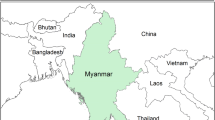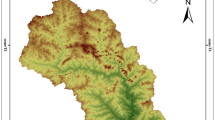Abstract
This study was carried out to simulate the forest cover changes in India using Land Change Modeler. Classified multi-temporal long-term forest cover data was used to generate the forest covers of 1880 and 2025. The spatial data were overlaid with variables such as the proximity to roads, settlements, water bodies, elevation and slope to determine the relationship between forest cover change and explanatory variables. The predicted forest cover in 1880 indicates an area of 10,42,008 km2, which represents 31.7% of the geographical area of India. About 40% of the forest cover in India was lost during the time interval of 1880–2013. Ownership of majority of forest lands by non-governmental agencies and large scale shifting cultivation are responsible for higher deforestation rates in the Northeastern states. The six states of the Northeast (Assam, Manipur, Meghalaya, Mizoram, Nagaland, Tripura) and one union territory (Andaman & Nicobar Islands) had shown an annual gross rate of deforestation of >0.3 from 2005 to 2013 and has been considered in the present study for the prediction of future forest cover in 2025. The modelling results predicted widespread deforestation in Northeast India and in Andaman & Nicobar Islands and hence is likely to affect the remaining forests significantly before 2025. The multi-layer perceptron neural network has predicted the forest cover for the period of 1880 and 2025 with a Kappa statistic of >0.70. The model predicted a further decrease of 2305 km2 of forest area in the Northeast and Andaman & Nicobar Islands by 2025. The majority of the protected areas are successful in the protection of the forest cover in the Northeast due to management practices, with the exception of Manas, Sonai-Rupai, Nameri and Marat Longri. The predicted forest cover scenario for the year 2025 would provide useful inputs for effective resource management and help in biodiversity conservation and for mitigating climate change.








Similar content being viewed by others
References
Apan A A and Peterson J A 1998 Probing tropical deforestation: The use of GIS and statistical analysis of georeferenced data; Appl. Geogr. 18 137–152.
Bax V, Francesconi W and Quintero M 2016 Spatial modelling of deforestation processes in the Central Peruvian Amazon; J. Nat. Conserv. 29 79–88.
Choudhari D K 2013 Uncertainty modelling for asynchronous time series data with incorporation of spatial variation for land use or land cover change; M.Sc. thesis, Indian Institute of Remote Sensing, Dehradun.
Clark N E, Boakes E H, McGowan P J, Mace G M and Fuller R A 2013 Protected areas in South Asia have not prevented habitat loss: A study using historical models of land-use change; PloS One 8 (5) e65298.
Dutta K, Reddy C S, Sharma S and Jha C S 2016 Quantification and monitoring of forest cover changes in Agasthyamalai Biosphere Reserve, Western Ghats, India (1920–2012); Curr. Sci. 110 (4) 508–520.
Eastman J R 2006 IDRSI 15 andes, In: Guide to GIS and Image Processing, Clark University, Worcester, MA.
FAO (Food and Agriculture Organisation of the United Nations) 2005 State of the world’s forests; FAO, Rome.
Gadgil M and Guha R 1993 This fissured land:An ecological history of India; Univ. California Press.
Hansen M C, Stehman S V and Potapov P V 2010 Quantification of global gross forest cover loss; Proc. Nat. Acad. Sci. USA 107 8650–8655.
Harikrishna P, Reddy C S, Singh R and Jha C S 2013 Landscape level analysis of disturbance regimes in Protected Areas of Rajasthan, India; J. Earth Syst. Sci. 123 467–478.
Ingram J C and Dawson T P 2005 Technical Note: Inter-annual analysis of deforestation hotspots in Madagascar from high temporal resolution satellite observations; Int. J. Remote Sens. 26 (7) 1447–1461.
Jha S and Bawa K S 2006 Population growth, human development and deforestation in biodiversity hotspots; Conserv. Biol. 3 906–912.
Lambin E F et al. 2001 The causes of land-use and land-cover change: Moving beyond the myths; Global Environ. Change 11 (4) 261–269.
Lambin E F 1994 Modelling deforestation processes: A review; EUR 15744 EN, TREES series B: Research Report No. 1; Joint Research Centre, Institute for Remote Sensing Applications; European Space Agency, Luxembourg, Office for Official Publications of the European Community, 128p.
Liebetrau A M 1983 Measures of Association (Quantitative Applications in the Social Sciences, No. 32); SAGE Publications, Newbury Park, CA.
Mas J F, Kolb M, Paegelow M, Olmedo M C and Houet T 2014 Modelling land use/cover changes: A comparison of conceptual approaches and softwares; Environ. Model. Softw. 51 94–111.
Meher-Homji V M 1989 History of vegetation of peninsular India; Man Environ. 13 1–10.
MOEF (Ministry of Environment and Forests) 2008 National Biodiversity Action Plan, Government of India, New Delhi, India, 100p.
Olander L P, Gibbs H K, Steininger M, Swenson J J and Murray B C 2008 Reference scenarios for deforestation and forest degradation in support of REDD: A review of data and methods; Environ. Res. Lett. 3 025011.
Puyravaud J P 2003 Standardizing the calculation of the annual rate of deforestation; For. Ecol. Manag. 177 593–596.
Ravindranath N H, Murthy I K, Joshi P, Upgupta S, Mehra S and Srivastava N 2014 Forest area estimation and reporting: Implications for conservation, management and REDD + ; Curr. Sci. 106 1201–1206.
Reddy C S, Jha C S and Dadhwal V K 2013 Assessment and monitoring of long-term forest cover changes in Odisha, India, using remote sensing and GIS; Environ. Monit. Assess. 185 4399–4415.
Reddy C S, Jha C S, Dadhwal V K, Harikrishna P, Pasha S V, Satish K V, Dutta K, Saranya K R L, Rakesh F, Rajashekar G and Diwakar P G 2016a Quantification and monitoring of deforestation in India over eight decades (1930–2013); Biodiv. Conserv. 25 93–116.
Reddy C S, Rakesh F, Jha C S, Athira K, Sonali Singh, Alekhya V V L P, Rajashekar G, Diwakar P G and Dadhwal V K 2016b Geospatial assessment of long-term changes in carbon stocks and fluxes in forests of India (1930–2013); Global Planet. Change 143 50–65.
Ribbentrop B 1990 Forestry in British India; Indus Publishing Company, pp. 9–24.
Richards J F and Flint E P 1994 Historic land use and carbon estimates for south and southeast Asia 1880–1980 (ed.) Daniel R C, In: ORNL/CDIAC-61, NDP-046, Oak Ridge National Laboratory, Tennessee, USA, 326p.
Rosencranz A and Lele S 2008 Supreme Court and India’s Forests; Econ. Polit. Wkly, pp. 11–14.
Satish K V, Saranya K R L, Reddy C S, Hari Krishna P, Jha C S and Prasada Rao P V V 2014 Geospatial assessment and monitoring of historical forest cover changes in Nilgiri Biosphere Reserve, Western Ghats, India (1920–2012); Environ. Monit. Assess. 186 (12) 8125–8140.
Tian H, Banger K, Bo T and Dadhwal V K 2014 History of land use in India during 1880–2010: Large-scale land transformations reconstructed from satellite data and historical archives; Global Planet. Change 121 78–88.
Vieilledent G, Grinand C and Vaudry R 2013 Forecasting deforestation and carbon emissions in tropical developing countries facing demographic expansion: A case study in Madagascar; Ecol. Evol. 3 (6) 1702–1716.
Acknowledgements
The present work has been carried out as part of ISRO’s National Carbon Project. The authors are grateful to the ISRO-DOS Geosphere Biosphere Programme for financial support.
Author information
Authors and Affiliations
Corresponding author
Additional information
Corresponding editor: D Shankar
Rights and permissions
About this article
Cite this article
REDDY, C.S., SINGH, S., DADHWAL, V.K. et al. Predictive modelling of the spatial pattern of past and future forest cover changes in India. J Earth Syst Sci 126, 8 (2017). https://doi.org/10.1007/s12040-016-0786-7
Received:
Revised:
Accepted:
Published:
DOI: https://doi.org/10.1007/s12040-016-0786-7




